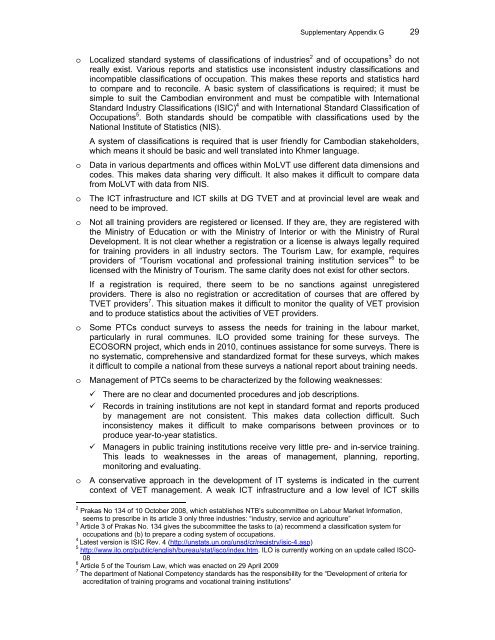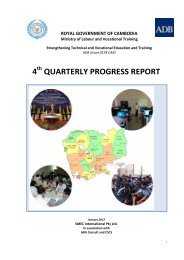Strengthening Technical and Vocational Education and Training ...
Strengthening Technical and Vocational Education and Training ...
Strengthening Technical and Vocational Education and Training ...
You also want an ePaper? Increase the reach of your titles
YUMPU automatically turns print PDFs into web optimized ePapers that Google loves.
Supplementary Appendix G 29<br />
o Localized st<strong>and</strong>ard systems of classifications of industries 2 <strong>and</strong> of occupations 3 do not<br />
really exist. Various reports <strong>and</strong> statistics use inconsistent industry classifications <strong>and</strong><br />
incompatible classifications of occupation. This makes these reports <strong>and</strong> statistics hard<br />
to compare <strong>and</strong> to reconcile. A basic system of classifications is required; it must be<br />
simple to suit the Cambodian environment <strong>and</strong> must be compatible with International<br />
St<strong>and</strong>ard Industry Classifications (ISIC) 4 <strong>and</strong> with International St<strong>and</strong>ard Classification of<br />
Occupations 5 . Both st<strong>and</strong>ards should be compatible with classifications used by the<br />
National Institute of Statistics (NIS).<br />
A system of classifications is required that is user friendly for Cambodian stakeholders,<br />
which means it should be basic <strong>and</strong> well translated into Khmer language.<br />
o Data in various departments <strong>and</strong> offices within MoLVT use different data dimensions <strong>and</strong><br />
codes. This makes data sharing very difficult. It also makes it difficult to compare data<br />
from MoLVT with data from NIS.<br />
o The ICT infrastructure <strong>and</strong> ICT skills at DG TVET <strong>and</strong> at provincial level are weak <strong>and</strong><br />
need to be improved.<br />
o Not all training providers are registered or licensed. If they are, they are registered with<br />
the Ministry of <strong>Education</strong> or with the Ministry of Interior or with the Ministry of Rural<br />
Development. It is not clear whether a registration or a license is always legally required<br />
for training providers in all industry sectors. The Tourism Law, for example, requires<br />
providers of “Tourism vocational <strong>and</strong> professional training institution services” 6 to be<br />
licensed with the Ministry of Tourism. The same clarity does not exist for other sectors.<br />
If a registration is required, there seem to be no sanctions against unregistered<br />
providers. There is also no registration or accreditation of courses that are offered by<br />
TVET providers 7 . This situation makes it difficult to monitor the quality of VET provision<br />
<strong>and</strong> to produce statistics about the activities of VET providers.<br />
o Some PTCs conduct surveys to assess the needs for training in the labour market,<br />
particularly in rural communes. ILO provided some training for these surveys. The<br />
ECOSORN project, which ends in 2010, continues assistance for some surveys. There is<br />
no systematic, comprehensive <strong>and</strong> st<strong>and</strong>ardized format for these surveys, which makes<br />
it difficult to compile a national from these surveys a national report about training needs.<br />
o Management of PTCs seems to be characterized by the following weaknesses:<br />
� There are no clear <strong>and</strong> documented procedures <strong>and</strong> job descriptions.<br />
� Records in training institutions are not kept in st<strong>and</strong>ard format <strong>and</strong> reports produced<br />
by management are not consistent. This makes data collection difficult. Such<br />
inconsistency makes it difficult to make comparisons between provinces or to<br />
produce year-to-year statistics.<br />
� Managers in public training institutions receive very little pre- <strong>and</strong> in-service training.<br />
This leads to weaknesses in the areas of management, planning, reporting,<br />
monitoring <strong>and</strong> evaluating.<br />
o A conservative approach in the development of IT systems is indicated in the current<br />
context of VET management. A weak ICT infrastructure <strong>and</strong> a low level of ICT skills<br />
2<br />
Prakas No 134 of 10 October 2008, which establishes NTB’s subcommittee on Labour Market Information,<br />
seems to prescribe in its article 3 only three industries: “industry, service <strong>and</strong> agriculture”<br />
3<br />
Article 3 of Prakas No. 134 gives the subcommittee the tasks to (a) recommend a classification system for<br />
occupations <strong>and</strong> (b) to prepare a coding system of occupations.<br />
4<br />
Latest version is ISIC Rev. 4 (http://unstats.un.org/unsd/cr/registry/isic-4.asp)<br />
5<br />
http://www.ilo.org/public/english/bureau/stat/isco/index.htm. ILO is currently working on an update called ISCO-<br />
08<br />
6<br />
Article 5 of the Tourism Law, which was enacted on 29 April 2009<br />
7<br />
The department of National Competency st<strong>and</strong>ards has the responsibility for the “Development of criteria for<br />
accreditation of training programs <strong>and</strong> vocational training institutions”





